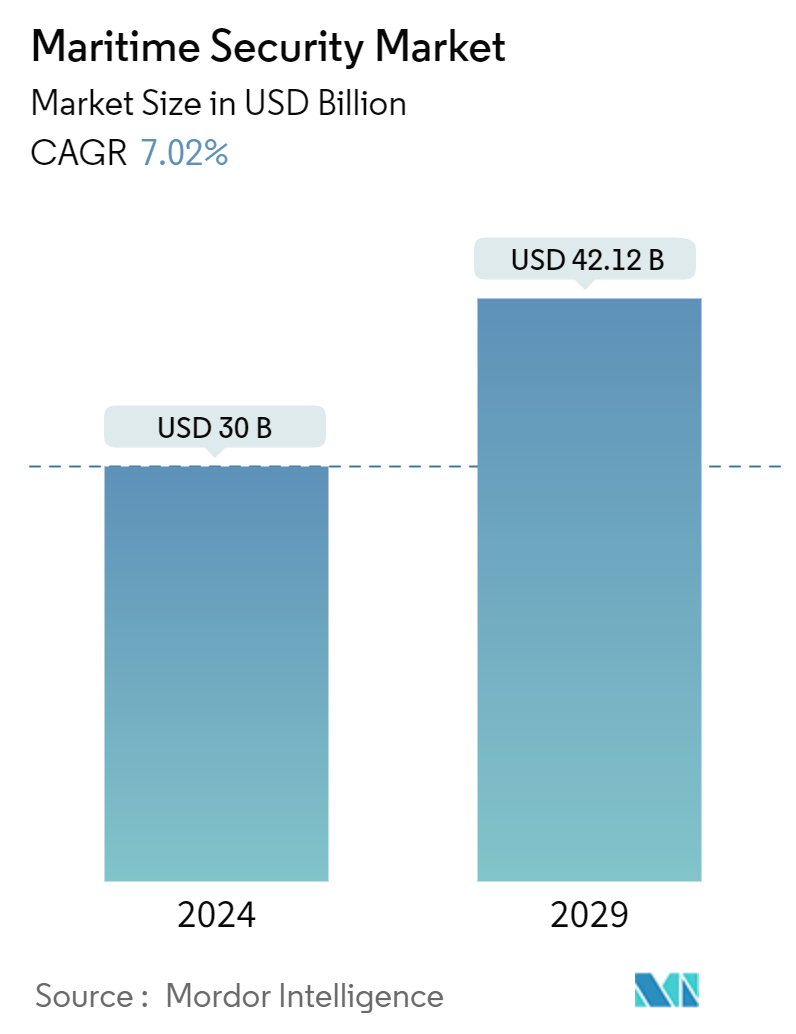Market Size of Maritime Security Industry

| Study Period | 2019 - 2029 |
| Market Size (2024) | USD 30 Billion |
| Market Size (2029) | USD 42.12 Billion |
| CAGR (2024 - 2029) | 7.02 % |
| Fastest Growing Market | Asia Pacific |
| Largest Market | Asia-Pacific |
Major Players
*Disclaimer: Major Players sorted in no particular order |
Maritime Security Market Analysis
The Maritime Security Market size is estimated at USD 30 billion in 2024, and is expected to reach USD 42.12 billion by 2029, growing at a CAGR of 7.02% during the forecast period (2024-2029).
Because of the profound changes in the international strategic landscape, the configuration of the international security system has been undermined by growing hegemonism, unilateralism, and power politics, which have fueled several ongoing global conflicts. In 2023 and 2024, attacks by the Houthi militia on trade ships in the Red Sea region registered a significant rise, impacting the trade between Asia and Europe and alarming major militaries across the world. These attacks are a result of an escalation of the war between Israel and Hamas militants in Gaza.
Owing to these issues, the adoption of advanced digital platforms, secured software, and vessel monitoring tools has gained traction, and the trend of increased adoption rate of these platforms is expected to continue during the next decade. Moreover, an increase in maritime trade and transportation activities has also been marred by the rising incidents of trafficking of prohibited substances, illegal immigration, and attacks on ports and coastal areas, thereby driving the demand for maritime security equipment.
On the other hand, inconsistent and outdated national laws and regulations related to maritime security can create gaps in governance. These laws are often inconsistent or contradictory, leading to confusion when implementing naval security solutions. Different maritime laws and enforcement processes for each country make it difficult for companies to comply with requirements, which can lead to high costs and delays in implementing security solutions.
Maritime Security Industry Segmentation
Maritime security concerns the protection of vessels, ports, and other infrastructure related to the shipping business from intentional damage caused by terrorism, sabotage, or subversion.
The maritime security market is segmented by system, type, and geography. By system, the market is segmented into screening and scanning, communications, surveillance and tracking, and other systems. The other systems include command and control systems, gate or port access control systems, and cybersecurity systems. By type, the market is classified into port and critical infrastructure security, vessel security, and coastal security. The report also covers the sizes and forecasts for the maritime security market in major countries across different regions. For each segment, the market size is provided in terms of value (USD).
| System | |
| Screening and Scanning | |
| Communications | |
| Surveillance and Tracking | |
| Other Systems |
| Type | |
| Port and Critical Infrastructure Security | |
| Vessel Security | |
| Coastal Security |
| Geography | |
| North America | |
| Europe | |
| Asia-Pacific | |
| Rest of the World |
Maritime Security Market Size Summary
The maritime security market is poised for significant growth, driven by the evolving international strategic landscape and increasing global conflicts. The rise in attacks on trade ships, particularly in regions like the Red Sea, has heightened the need for advanced security measures. This demand is further fueled by the surge in maritime trade and transportation activities, which are often threatened by issues such as trafficking, illegal immigration, and port attacks. As a result, there is a growing adoption of digital platforms, secured software, and vessel monitoring tools. However, inconsistent national laws and regulations pose challenges, creating gaps in governance and complicating the implementation of security solutions. Despite these challenges, the need for advanced surveillance and tracking systems, especially in high-risk areas like Latin America, West Africa, and the Caribbean, continues to drive market growth.
The market is characterized by investments in new port infrastructure and terminal expansions, particularly in the Asia-Pacific region, to enhance security and surveillance systems. Countries like Japan, China, Australia, and Vietnam are making substantial investments to bolster their maritime capabilities, reflecting a broader trend of increasing procurement of surveillance systems in response to rising trade and maritime tensions. The market is semi-consolidated, with key players such as Thales, BAE Systems, and OSI Systems leading the charge in developing advanced detection and monitoring systems. These companies are actively expanding their product offerings to improve maritime border security, as evidenced by recent contracts and projects aimed at enhancing national security and maritime capabilities. Such strategic initiatives are expected to propel market growth and expand the geographical reach of these companies.
Maritime Security Market Size - Table of Contents
-
1. MARKET DYNAMICS
-
1.1 Market Overview
-
1.2 Market Drivers
-
1.3 Market Restraints
-
1.4 Technology Trends
-
1.5 Porter's Five Forces Analysis
-
1.5.1 Bargaining Power of Buyers/Consumers
-
1.5.2 Bargaining Power of Suppliers
-
1.5.3 Threat of New Entrants
-
1.5.4 Threat of Substitute Products
-
1.5.5 Intensity of Competitive Rivalry
-
-
-
2. MARKET SEGMENTATION
-
2.1 System
-
2.1.1 Screening and Scanning
-
2.1.2 Communications
-
2.1.3 Surveillance and Tracking
-
2.1.4 Other Systems
-
-
2.2 Type
-
2.2.1 Port and Critical Infrastructure Security
-
2.2.2 Vessel Security
-
2.2.3 Coastal Security
-
-
2.3 Geography
-
2.3.1 North America
-
2.3.2 Europe
-
2.3.3 Asia-Pacific
-
2.3.4 Rest of the World
-
-
Maritime Security Market Size FAQs
How big is the Maritime Security Market?
The Maritime Security Market size is expected to reach USD 30 billion in 2024 and grow at a CAGR of 7.02% to reach USD 42.12 billion by 2029.
What is the current Maritime Security Market size?
In 2024, the Maritime Security Market size is expected to reach USD 30 billion.

